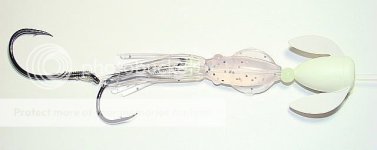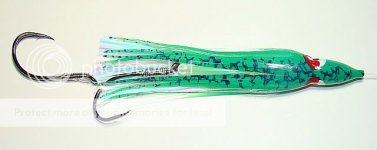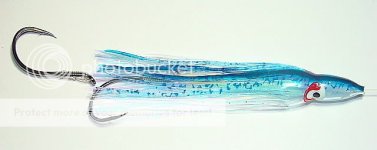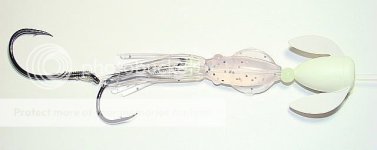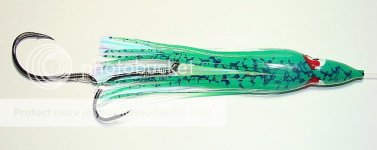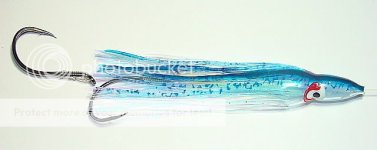I thought it might be useful to summarize my favorite lures and methods for salmon and hope that others will add their own. In this thread, I'm only looking for peoples favorite/most productive technique - e.g. your "Go To" methods. Here's mine:
1) a) 11" green glow flasher (I prefer these
 - not due to the e-chip but due to the fin) +
- not due to the e-chip but due to the fin) +
b) 24" of leader (you can tie your own or buy premade) +
c)green spatterback hootchie +
d) a silver or crystal twinkle skirt insert
Onto the leader slip on the twinkle skirt, then the hootchie and tie it off to the flasher so it trails about 24" back. Use 40# leaders so that the action of the flasher is better transmitted to the hootchie. Cut a fillet of herring and put it on the front hook. Troll from a down rigger as indicated in the first link.
2) Flasher + spoon - I use the same green glow flasher as above and any number of different kinds of spoons. However, the favorite spoons are:
a) 3.5 or 4" Coyote Spoons in the color patterns of
i) Funky Chicken (purple with some glow green and red/orange)
ii) Cop Car (black and white)
iii) Green splatterback
b) Coho killer green/white is a favorite color. The sonic edge spoons (at the same link as the coho killer spoons) are also good. Typically, spoons are run a bit farther back from the flasher (36") and on lighter line (15-20# test).
3) Cut plug herring There's a number of ways to rig these. If you don't have down riggers, a cut plug herring on a 4-6oz banana weight. This can be trolled out the back with a combination of weight, line out, line thickness and speed controlling the depth. For coho in the summer, just under the surface is fine. For returning coho or kings in the summer in the early AM, 20-30' down is good. You can use the same setup to mooch for salmon - e.g. jigging with a herring.. A cut plug herring on a simple banana weight either jigged or trolled is one of the simplest ways to catch salmon and the gear is cheap - a weight(with chain swivels attached), a couple of hooks and herring. The only down side to cut plugs is that if there are a lot of dogfish around, you often go through a lot of bait an leaders on the dog fish. Trolling faster will reduce that (sometimes), but when there are a lot of dogfish around, I go to spoons.
So that's my top 3 salmon catchers. If I was to recommend what someone new to salmon fishing should buy I'd say the following is a good basic set of tackle for saltwater salmon trolling:
1) 2 green flashers - 11" Pro troll with the fin (about $11/ea)
2) 1 red flasher - 11" Pro troll with the fin (about $11)
3) 1 silver prism flasher - 11" Pro troll with the fin (about $11)
4) 4 - 4 oz. banana weights (about $2-3/ea.)
5) 4 - 6 oz banana weights (about $2-3/ea.)
6) 24 pre-tied leaders 40# test (you can tie your own - I like the Owner cutting point hooks - buy barbless hook or de-barb after tying). If you wish to buy pre-tied leaders the Gamakatsu leaders are good. Figure $1-3/leader.
7) 2 coho killer spoons in green glow ($4/ea).
8) 2 coyote spoons in each of the following colors - cop car, funky chicken and green splatter back ($4/ea).
9) On flasher storage bag $16
10) Reel - there's a lot of good reels out there - anAbu garcia 6500 is nice and can be had for around $100 new, less used. A shimano Tekota reel with the line counter is great for trolling banana weights or for bottom fishing. They go for about $150.
11) Rod - again lots of choices - I like the 9' Lamiglass downrigger poles. For down rigger use, you want fiberglass rods as graphite rods tend to break after spending a lot of time in the bent shape. The Lamiglass rods are $110 on line - I got mine new for $65 at Outdoor Emporium's garage sale.
12) Line - I like to use 50-65# test Power Pro or Spider Wire braided line. These types of line are very strong and have a line diameter that is similar to much weaker monofilament line - e.g. 65# spider wire is the same diameter as 15-20# monofilament. Also, these braided lines have much less stretch are MUCH better for bottom fishing. 300yds will run about $25-30.
1) a) 11" green glow flasher (I prefer these
 - not due to the e-chip but due to the fin) +
- not due to the e-chip but due to the fin) +b) 24" of leader (you can tie your own or buy premade) +
c)green spatterback hootchie +
d) a silver or crystal twinkle skirt insert
Onto the leader slip on the twinkle skirt, then the hootchie and tie it off to the flasher so it trails about 24" back. Use 40# leaders so that the action of the flasher is better transmitted to the hootchie. Cut a fillet of herring and put it on the front hook. Troll from a down rigger as indicated in the first link.
2) Flasher + spoon - I use the same green glow flasher as above and any number of different kinds of spoons. However, the favorite spoons are:
a) 3.5 or 4" Coyote Spoons in the color patterns of
i) Funky Chicken (purple with some glow green and red/orange)
ii) Cop Car (black and white)
iii) Green splatterback
b) Coho killer green/white is a favorite color. The sonic edge spoons (at the same link as the coho killer spoons) are also good. Typically, spoons are run a bit farther back from the flasher (36") and on lighter line (15-20# test).
3) Cut plug herring There's a number of ways to rig these. If you don't have down riggers, a cut plug herring on a 4-6oz banana weight. This can be trolled out the back with a combination of weight, line out, line thickness and speed controlling the depth. For coho in the summer, just under the surface is fine. For returning coho or kings in the summer in the early AM, 20-30' down is good. You can use the same setup to mooch for salmon - e.g. jigging with a herring.. A cut plug herring on a simple banana weight either jigged or trolled is one of the simplest ways to catch salmon and the gear is cheap - a weight(with chain swivels attached), a couple of hooks and herring. The only down side to cut plugs is that if there are a lot of dogfish around, you often go through a lot of bait an leaders on the dog fish. Trolling faster will reduce that (sometimes), but when there are a lot of dogfish around, I go to spoons.
So that's my top 3 salmon catchers. If I was to recommend what someone new to salmon fishing should buy I'd say the following is a good basic set of tackle for saltwater salmon trolling:
1) 2 green flashers - 11" Pro troll with the fin (about $11/ea)
2) 1 red flasher - 11" Pro troll with the fin (about $11)
3) 1 silver prism flasher - 11" Pro troll with the fin (about $11)
4) 4 - 4 oz. banana weights (about $2-3/ea.)
5) 4 - 6 oz banana weights (about $2-3/ea.)
6) 24 pre-tied leaders 40# test (you can tie your own - I like the Owner cutting point hooks - buy barbless hook or de-barb after tying). If you wish to buy pre-tied leaders the Gamakatsu leaders are good. Figure $1-3/leader.
7) 2 coho killer spoons in green glow ($4/ea).
8) 2 coyote spoons in each of the following colors - cop car, funky chicken and green splatter back ($4/ea).
9) On flasher storage bag $16
10) Reel - there's a lot of good reels out there - anAbu garcia 6500 is nice and can be had for around $100 new, less used. A shimano Tekota reel with the line counter is great for trolling banana weights or for bottom fishing. They go for about $150.
11) Rod - again lots of choices - I like the 9' Lamiglass downrigger poles. For down rigger use, you want fiberglass rods as graphite rods tend to break after spending a lot of time in the bent shape. The Lamiglass rods are $110 on line - I got mine new for $65 at Outdoor Emporium's garage sale.
12) Line - I like to use 50-65# test Power Pro or Spider Wire braided line. These types of line are very strong and have a line diameter that is similar to much weaker monofilament line - e.g. 65# spider wire is the same diameter as 15-20# monofilament. Also, these braided lines have much less stretch are MUCH better for bottom fishing. 300yds will run about $25-30.

